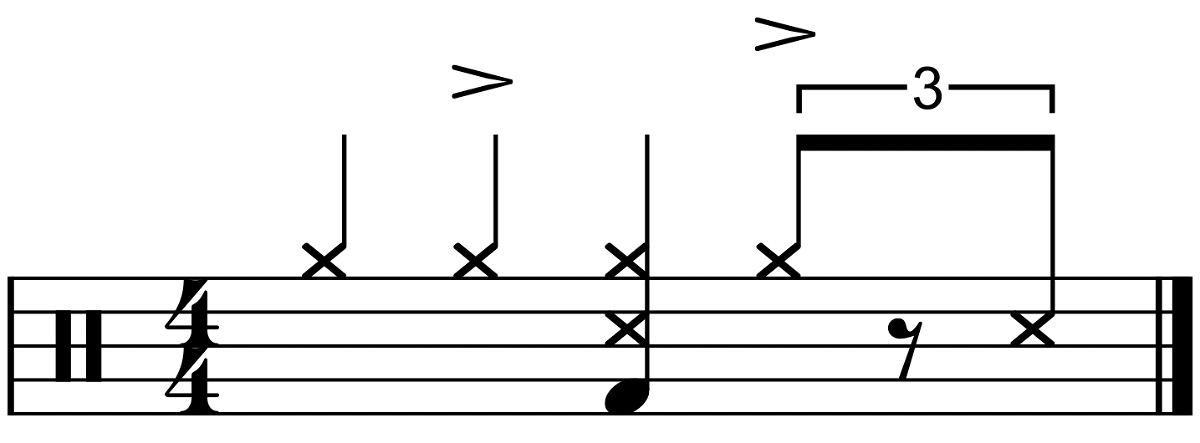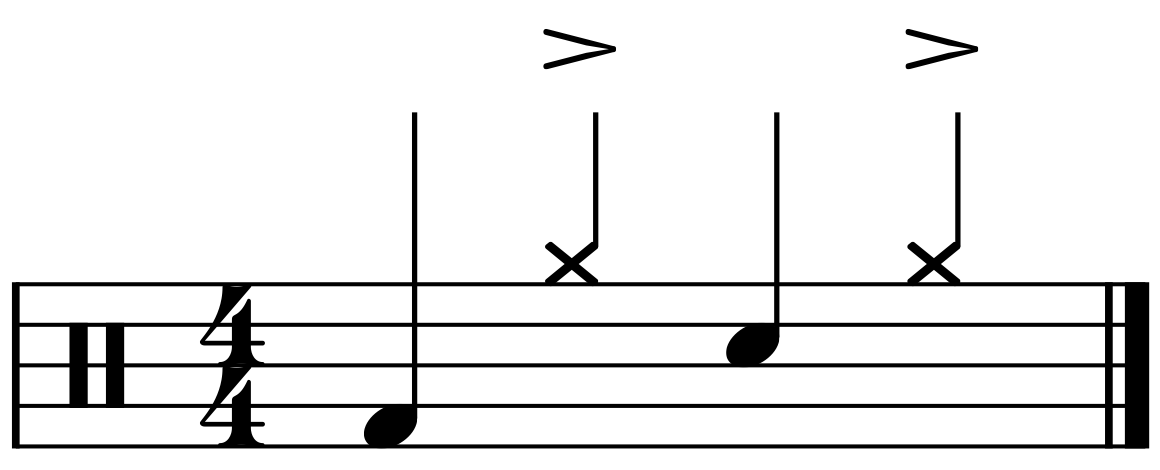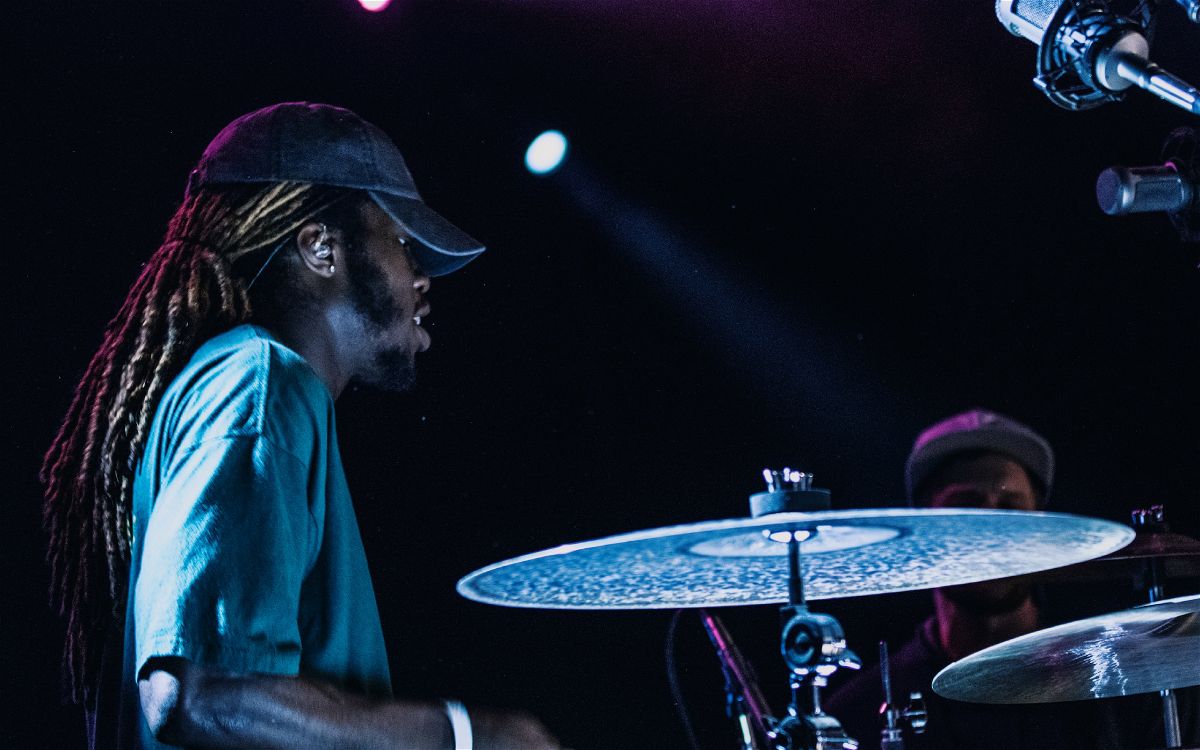Reggae is one of the most fun styles to play on the drums. The music is quite relaxed, but the vibrant nature of reggae drumming is what makes it so exciting.
The great thing about it is that it’s simple to learn at first. Most of the important reggae beats have plenty of space, so you don’t need to be technically proficient to be able to play them.
However, every reggae drum beat is all about feel. The better your feel behind the kit, the better these beats will sound.
Here are ten essential reggae grooves to learn. They range in difficulty, so start with the easy ones and then work your way up from there.
Contents
Reggae Drum Beats
Beat 1

This first groove is called a one drop reggae beat. It’s the most common pattern that you need to play in reggae music, as most tunes have this rhythm engrained in them.
If you’ve never played reggae beats before, this may feel a bit weird, as the bass drum is falling on a count that it wouldn’t typically fall on in pop music or rock music.
The idea behind the groove is that you need to accent beat three of the bar. You can do that by playing a cross-stick on the snare drum and a note on the bass drum at the same time.
You should then play the hi-hats on beats two and four a bit louder to get a nice offbeat feel. Work on playing this groove at various tempos, as some reggae tunes have it quite slow while others are a lot faster.
Beat 2

This next groove follows off the back of the last one. It’s the same one drop beat, but you’re going to add an extra cross-stick to give it a bouncier feel.
That cross-stick will come on the “and” of beat four, but it’s going to sound better if you play it with a swing feel. The closer you can get that last cross-stick to the first beat of the next bar, the better the groove will sound.
Remember to keep accenting the offbeats on the hi-hat as well.
Beat 3

This groove takes inspiration from a classic shuffle beat. You’re going to play a straightforward shuffle pattern on the hi-hat, but you’re going to keep the one drop feel with your bass drum and snare drum.
The trick here is that you still need to accent all the offbeats on the hi-hat. That’s what will make the groove sound appropriate for reggae music.
I’d suggest working on this beat very slowly at first. It will then be helpful to be able to play it up to about 140 BPM eventually.
Beat 4

This next groove keeps the one drop pattern on your kick drum, but everything else changes with your hands.
On the hi-hat, you’re just going to play quarter notes, and you’re going to accent beats two and four.
On the snare drum, you’re going to play a repeating cross-stick pattern that has syncopated rhythms. You’ll start on beat one, and then there will be two syncopated cross-sticks before you land on the final one of beat four.
Try to add as much swing to this groove as you can, and it will sound fantastic.
Beat 5

Here’s a very basic beat that will offer a change of pace from the last few. It’s essentially a disco drum beat, but it fits very well in up-tempo reggae songs.
It’s a linear beat, meaning you don’t play any drums or cymbals at the same time, so it’s arguably the easiest groove to learn out of all of these.
It starts with a bass drum on beat one. It moves to an accented hi-hat on beat two. Then you play an open snare drum on beat three, and then you end with another accented hi-hat on beat four.
You can also play a cross-stick on beat three if that better suits the music.
This groove will typically be played at very high speeds.
Beat 6

This next groove has the same feel as the last one, but it’s not a linear pattern anymore. For this one, you’re going to fill in the space by playing eighth notes on the hi-hat.
While you’re playing those, you’re going to play accents on the offbeats. By this point, you’ve probably realized that offbeat accents are present in almost every reggae beat.
You’ll need to work on your hi-hat technique to be able to play this one at faster tempos.
Beat 7

Here’s one of my favorite reggae drum beats. It’s a bit harder to learn than most of the others, simply due to the space that you need to leave between every group of notes. Having that space is essential for nailing the feel of the groove.
For this groove, you’re going to leave a rest on the first beat of the bar, and then you’re going to play two quick notes on your hi-hat before landing your snare and bass drum together.
You’ll then leave a rest on beat three of the bar before playing the same pattern again.
Beat 8

This groove is one that regularly comes out in busy choruses in reggae music. There are three distinct spots in the bar that form a repeating rhythm, and then you’re just filling out the rest of the groove with notes on the hi-hat or ride cymbal.
The beat sounds big and open when you play it on the ride. You can even play it on the bell to make it sound a bit punchier.
You’ll be playing the shuffle pattern again with your right hand while your snare drum and bass drum land three times within the bar. It often sounds great if you play a strong accent on beat four.
Beat 9

This groove is the most unique out of all the ones we’ve looked at so far, but it also has the potential to sound the grooviest.
You’re going to play straight 16th notes on the hi-hat, and then you’re going to play your bass drum and floor tom on beats two and four.
In between playing those, you’re going to fill in a few bass drum notes to drive the groove forward. Remember to keep the hi-hat accents on all the offbeats to make the groove sound as “reggae” as possible.
Beat 10

The final groove is another easy one. It’s similar to the linear disco one from before, but you’re going to add an extra bass drum note to make the groove swing.
That extra bass drum will fall just before the last hi-hat note in the bar. Again, the closer you place that bass drum to the hi-hat on beat four, the groovier this beat will sound. It will sound even better if you place strong accents on beats two and four.
Tips for Playing Reggae Drums
Mastering the Straight and Swing Feels
One of the trickier parts of reggae drumming is switching between straight and swing feels. It often sounds a lot better within the music if you play a blend of the two. To be able to do that, you need to have a strong foundational ability to play both.
It’s a good idea to play all the grooves we’ve looked at as straight as possible. Then try to play them all with a swing feel. Once you’ve done that, try to play a mixture of the two as you play the grooves over and over.
Work on Your Shuffles
Most reggae drum beats have underlying shuffle rhythms. Even if you don’t actively play them, you can feel them within the grooves.
The better you are at playing shuffles, the better you’ll be at playing reggae grooves. So, work on your hi-hat shuffle patterns as much as you can to improve your overall ability to play reggae drum beats.
Get a Good Cross-Stick Sound
Every reggae groove needs to have a strong cross-stick sound. The best way to do that is by flipping your stick over so that the butt end is hitting the rim. You’ll get a rounder sound that is a bit louder.
It could also be beneficial to get a wooden attachment to place on your snare drum that is designed to get better and stronger cross-stick sounds.
Conclusion
The more you play along with reggae music, the better you’ll get at recognizing what the feel should be. Most of the drum beats we looked at above will work with any reggae tune.
So, learn how to play all of them and then find a reggae playlist to jam out to. Once you feel comfortable with the one drop feel, most reggae songs should be fairly easy to pick up.
Remember to subtly switch between straight and swing feels while playing these drum grooves. They’ll sound fantastic when you do.









